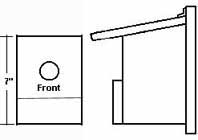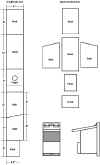|
In the wild, birds like tits, finches and
blackbirds prefer to nest naturally in hollow tree-trunks, or in
the cavities of rotten branches. Many people believe that making a
bird-box is relatively easy, but each one is tailor-made for each
specie of bird.
| The most common type is like the one pictured
below to the right. In
our garden we decided
to put up this type of small bird boxes, to help and
encourage more wildlife to visit the garden. This would
enhance the specie diversity of the area, and hopefully
provide enjoyment for all guests who visit. We decided to
have two types of boxes - i.e. two different hole sizes.
Out of the six that were made, three of them have a 28mm
hole, and the rest are 22mm. The particular species
attracted to our boxes will depend on the
local distribution and population within the garden, and on the
size of hole provided in the nest-box. The entrance holes of our
boxes with attract a variety of birds, for example Blue Tits,
Great Tits, Coal Tits, Tree Sparrows and Pied Flycatchers. |
 |
Small Bird Boxes
1.)
Design
There is no standard, accurate
design for a nest box. Birds do not insist on their nest sites being
mathematically precise! What they do require is a nest site which is
secure and weatherproof, and as safe as possible from predators. Different
bird species favour different types and locations of nesting sites, and so
boxes must be constructed accordingly to meet these different needs. Two
basic designs however will accommodate most common garden birds; either a
partly open-fronted box, or a box with a circular hole at the front (of
varying diameter for different species).
Dimensions
need not be precise; make the box to suit the materials available rather
than buying materials to match any given dimensions.
To
make the box shown above, click on the thumbnail below for the
plans:
 |
The
design: The roof should be hinged, for ease of cleaning out,
either by a non-ferrous hinge and screws or by a rubber strip. The
dimensions are only an approximate guide and are by no means
critical; but if they are followed, this box can be made from one
48 inch piece of timber, 6 inches wide, and 0.75 inch thick.
The box may be screwed or nailed together, and small drainage
holes should be drilled in the floor
2.)
Materials
Undoubtedly wood is the best material to use; new or old wood,
rough or planed, softwood or hardwood - it is really not
important. Use what is available.
A thickness of about 0.75
inches is ideal. Manufactured
board (plywood and chipboard) are not suitable for outdoor use (except for
resin-bonded marine quality ply, which can be expensive), although they
are perfectly acceptable for a nest box placed under cover, for example a
Barn Owl box placed in an old building. After
construction, the outside only
of the box should be treated with a wood preservative (creosote, 'Cuprinol',
'Sadolin', etc.) To prolong its life and help repel water. If
using planed timber, clear polyurethane may be used instead. All boxes
should be treated annually in this way and allowed to dry thoroughly
before being erected. A piece of roofing felt fixed to the roof will also
prolong the life of the box and render it more waterproof. |
3.)
Siting of nest
boxes
For nest boxes with open fronts and small entrance holes:
-
Height
Whether fixed to a tree or a wall, the height above ground is not
critical to most species of bird, so long as the box is clear of
inquisitive humans and prowling cats.
-
Aspect
If there is no natural shelter, it is best to mount a box facing
somewhere between south-east and north, to avoid strong direct
sunlight and the heaviest rain. The box should be tilted slightly
forwards so that the roof may deflect the rain from the entrance.
-
Predators
It may be possible to deter predators by fixing the nest box in a
thorny bush or by placing chicken-wire around the entrance, but always
ensure a direct flight-path to the entrance. If squirrels or
woodpeckers are a serious threat, fix a metal plate around the
entrance, so that it can not be enlarged.
-
Fixing
Some authorities recommend nails to attach the box directly to a tree
trunk or branch; others prefer the use of rope or wire right around
the box and trunk (remembering to protect the trunk from wire cutting
in by the use of a piece of rubber or the like). Both methods are
satisfactory, but obviously annual maintenance is easier if the box is
wired and can thus be taken down easily for cleaning.
-
Number
The number of nest boxes which can be placed in a garden depends on
the species you wish to attract. Many species are fiercely
territorial, such as Blue Tits, and will not tolerate another pair
close by. About 2 to 3 pairs per acre is the normal density for Blue
Tits. Other species such as Tree Sparrow, which are colonial nesters,
will happily nest side by side.
Do not place any nest box close to a bird-table or feeding area, as
the regular comings and goings of many other birds are likely to
prevent breeding in the box.
-
Annual
cleaning of nest boxes
After the end of each breeding season, all nest boxes should
be taken down and the old nesting materials removed, and the box
should be scolded with boiling water to kill any parasites. Do not use
insecticides or flea-powders - boiling water is adequate. Annual
cleaning is best carried out in October or November.
Under the terms of the Wildlife and Countryside Act 1981, if unhatched
eggs are found in the box, they can only legally be removed from
October to January inclusive, and they must be destroyed! It is
illegal to keep them.
-
Winter
Leave the bird box up in winter as it will be useful as a roosting
site for birds in bad weather.
Top
of Page
|

